
Pet Leopard Geckos: Care & Info
by Animals
This is some basic information on how to care for your pet leopard gecko (Eublepharis macularius), and some suggestions for "leo" lovers.
What are leopard geckos?
What's in a name?
The leopard gecko's scientific name is Eublepharis macularius. The genus (Eublepharis) refers to the fact that leopard geckos have real eyelids ("Eu-" means "good" or "true"). The species (macularius) refers to the gecko's spotted skin - this part of the name might be familiar to you from words like "immaculate" ("spotless")!
Funny habits
Leopard geckos are known for their fondness of hiding during the daytime, which is why owners of pet leopard geckos always provide a few "hides," or small covered spaces to make their geckos feel safe. Geckos have a funny way of showing they feel secure, though: they will often sleep with a leg or foot dangling out of the hide in a very uncomfortable-looking way! Your gecko may look as if he's injured or stuck, but there's a good chance he's just dozed off.
Being reptiles, leopard geckos don't have hair or fur to grow, or feathers to molt. Instead, they shed their skin. While mammals shed old, dry skin gradually and in very small amounts, geckos shed much less often and all in one day! Your gecko may look pale or dried-out for a few days before shedding, and may lose his appetite. Then one day, he has a bold bright new skin on with no sign of the old one! He has shed the old skin, and since a shed skin contains nutrients and might attract predators, the fastidious fellow has gobbled it up.
Providing a waterproof container (a simple Tupperware or other plastic container with no sharp edges and a gecko-sized "door" cut in it will do just fine) filled with a damp medium like wet paper towels or moss will help your gecko loosen his old skin and complete the shedding process quickly and completely. Put it in a cooler part of the cage so the water doesn't evaporate as fast. And give your gecko a little privacy when he sheds - you wouldn't want someone walking into your room and turning on all the lights every time you changed into your pajamas!
Where do they live?
Leopard geckos (or "leos," as gecko lovers affectionately call them) come from arid climates in the Middle East. It's hot, dry and rocky where leos live, which explains why they like to hide in small nooks and crannies out of the sunlight. It also explains why a lot of people like to use slate or other kinds of tile for their captive geckos' habitats - they give a very "natural" look as well as being easy to clean, holding heat well, and removing the risk of your gecko scooping up a mouthful of his bedding when he lunges at a juicy bug.
My own gecko managed to do this when I had a small sandy area in a corner of his cage: insects tried to escape into it, and he ended up gobbling up sand with his meal. Luckily I caught the problem quickly and the little fellow didn't suffer too much discomfort! If you think your leo might be eating his bedding by accident, you'll want to switch over to something a little "harder to swallow" before it has the chance to cause serious digestive problems.
Lizards, snakes, turtles and other reptiles are ectotherms, which means their temperature (-therm) is regulated from outside the body (ecto-). Instead of generating all the warmth they need to be active and digest their food, reptiles need an external heat source to fire up the furnace.
Geckos are nocturnal, which means they are most active between sunset and sunrise. While a lot of common pet lizards like bearded dragons and iguanas are active in the daytime and prefer to "bask" in the sun or under a sun lamp to warm up, leopard geckos can take in residual heat from the ground at the end of the day. This means their bellies are most efficient at absorbing heat, and they do best with an under-tank heater, or UTH. These heaters or "heating pads" (along with a thermometer and thermostat to keep the temperature around 88F-90F without dropping or spiking) are also available at most pet stores and online. Without heat, your gecko will become lethargic and be unable to digest her food properly. Without a "cool side" (one to two thirds of the cage or vivarium that do not have a heating pad underneath), your gecko will become overheated, which can also result in reduced activity, as well as dehydration.
What do they eat?
Leopard geckos are insectivores: their meal of choice is the live adults and larvae (grubs, caterpillars, etc.) of various nonpoisonous insects. This means that freeze-dried crickets or other "dead" food probably won't go over well with your leo; they do not normally eat plants or carrion, so food that doesn't wriggle around doesn't generally come across as food to them. When they do eat, they tend to snarf down quite a bit and then wait a few days to let it all digest. Young geckos tend to eat more and more often though, and individual adults may eat more or less, so pay attention and let your gecko tell you what his own personal feeding schedule is!
You can buy crickets and mealworms (larvae of the darkling beetle Tenebrio molitor) in most pet stores, and these will provide a good everyday variety for your gecko. If you want a treat for your gecko, though, or would like to feed him something more nutritious or easier to keep in your home, there's an impressive variety of options.
Tropical roaches are a popular choice, as they do not smell, do not sing, are relatively easy to raise, have a lot of food value per insect, and are not cold-tolerant enough to infest homes in temperate climates if they escape. "Superworms" (larvae of the darkling beetle Zophobas morio) are another popular tropical species; the beetles have too much shell to be good for food, but the larvae are large and active, which may help tempt picky geckos. A benefit of superworms is that they will not generally turn into pupae (the inactive stage in between "worms" and beetles) at room temperature if they are kept in groups. Mealworms, which resemble small superworms, will eventually turn into pupae and inedible beetles unless kept cold (a container in the refrigerator is the usual solution), which makes them easy to breed but more difficult to "keep" if your gecko eats slowly. Superworms are also more tolerant of moisture, though you should still make sure there is plenty of ventilation to avoid mold and mites.
Other feeders, like silkworms, "butterworms" (larvae of the moth Chilecomadia moorei), "Calciworms" or "Phoenix Worms" (common brand names for the larvae of the black soldier fly, Hermetia illucens) are great sources of variety in your gecko's diet, but are not usually used as staples due to price, availability, palatability, hardiness, or nutritional value.
You are what you eat
You'll want to be sure to give healthy food to the insects your gecko eats. Potatoes are a good source of water for insects (they tend to drown in standing water), and chunks of fruits and veggies like carrots, apples, etc. will be converted into nutrients by the insects. Let them eat for 24 hours or so before giving them to your leo. You can purchase commercial "gutload" for the more common species, or you can do some research and mix up your own. Just remember to use quality gutload or ingredients - if you skimp and feed your insects spoiled or questionable food, you're feeding it to your gecko as well!
You'll also want to "dust" your gecko's food with calcium every other feeding or so. Calcium deficiency is a common problem in geckos kept in captivity without access to calcium. They will consume calcium powder now and then from a dish when it's made available, a bit like livestock use salt licks, but dusting the insects ensures that even picky eaters get a good dose.
Is a leopard gecko for me?
Personality
Like any animal, leopard geckos have unique personalities. However, geckos generally do not appreciate "companionship" the way a dog or parrot might. Like cats, they are solitary animals. A gecko does not need another gecko to play with, and they are not particularly "affectionate." However, if you do not mind giving your gecko her space when she wants it, a gecko can be a very rewarding pet. A gecko who trusts you may take food from your hand, sit on your shoulder, and even come running to you for protection if she escapes from her cage!
Juvenile or adult?
If you have enough patience (and enough food!), a young gecko could be just the thing for you. You will know from an early age what your gecko eats, what experiences he has had, and what illnesses he may have been exposed to. You can watch his pattern and coloring develop (leos with a wild-type "morph" or pattern start out with black-and-yellow bands, scattering into spots as they grow), you can see his personality develop and you can help him to become a calm, trusting adult. However, "juvies" can be frustrating for some. They tend to overcompensate for being helpless babies by acting like raging terrors, screaming and hissing when frightened. You will very likely be bitten or threatened by your baby gecko at some point, and while they are not capable of causing much pain at this point, if you are easily startled you might want to start out with a calmer adult!
If you buy an adult from a breeder, you have fewer surprises. Your gecko's coloring, size, and gender will be easy to determine. The breeder can tell you the gecko's age, and any personality quirks that may make feeding or handling a hassle. Your gecko may take longer to adjust to being removed from his home, and you will not be able to watch him grow and mature, but some of the guesswork and worry are removed. If you are buying an adult from a pet store, you will want to make sure he has a fat tail, brightly-colored skin, and clear, open eyes. Make sure the cage in the pet store is clean and suitable for a leopard gecko. Not all pet stores know how to care for "unusual" pets like reptiles, and buying an unhealthy gecko from such a store supports poor care and may result in vet bills and heartbreak on your part. Buy wisely!
Checklist
Here's what you'll want to have before you buy your gecko!
- Tank or similar container, 10 gallons or more per gecko, to house your leo.
- Suitable substrate or floor covering for the tank (non-glossy tiles, paper towels, or other material that will not be eaten or get too slippery or hot)
- Water dish (shallow dishes dry up faster, but geckos may be uncomfortable with a dish that is too large or deep)
- At least three "hides" (purchased at a pet store or made of clean, nontoxic materials like plastic containers, wood, pottery - get creative!), one of which is a covered "humid hide" filled with damp material when your gecko is shedding.
- Under-tank heater (UTH)
- Thermometer to read cage temperature
- Thermostat or rheostat (cheaper but less accurate) to keep temperature stable.
- Calcium powder (available at pet stores); dust this on feeder insects once a week as well as providing a small dish of calcium to ensure that your gecko gets enough.
- Food! Don't wait till your gecko is home to decide what you're going to feed it and/or set up a colony of feeder insects.
- A place to put the cage, preferably off the carpet and other insulating surfaces (you don't want the UTH to overheat) and in a room with windows so your gecko has a sense of day and night. Some geckos will come out in the day if they feel comfortable!
- A little time each day to enjoy your new pet!
You might also like
Searching for a Turtle NestMomma Turtle is ready to lay her eggs. She climbs up the bank, scratches the ...
Black Snakes in VirginiaBlack snakes are very common in Virginia. There are three kinds of black sna...
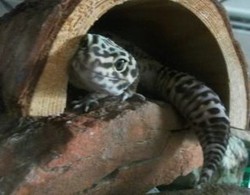

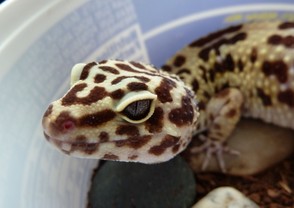
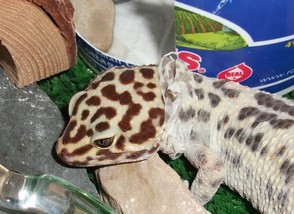
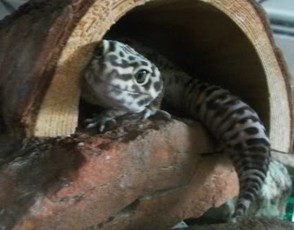
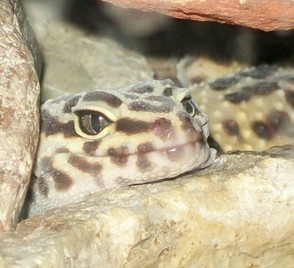







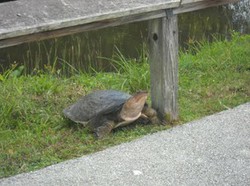
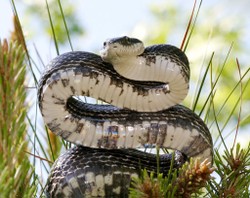
Comments
Chloe: Thanks for dropping by!
I typically place mine somewhere in the "gradient" area between hot and cool; on the hot side it will evaporate quickly, while if it's in the coldest part your leo might become uncomfortably cool in the moist hide. Placing it in the middle makes it more of a "warm bath." :) But it's not an exact science. So as long as you make sure it's moist when your gecko needs it (around shedding time), s/he isn't having shedding issues, and you avoid placing plastic right on a heat source, you should be fine wherever you choose to position it.
which side does the moist hide go on?
I've been putting it on the warm side, but there is a lottery room on the cool side, so I don't know if that switch would be okay.
Thank you!!!
I love leo's, we actually have quite a few of them - mostly Bell albinos. You did a great job on this care guide! Very thorough :)
Pukeko: I believe it is in fact legal to keep Leopard Geckos as pets in New Zealand, though they are probably not as common!
ronpass: I would love to have geckos running wild in the yard. You must live somewhere warm!
Very informative article about the Leopard Gecko. We have heaps of Geckos that run up and down our windows at night but they are of the transparent variety. They are fascinating creatures - you can't see them during the day but at night they are everywhere. They seem to be gentle, silent animals with a mystical quality.
Fantastic information on leopard geckos. I am pretty sure there are none of these in New Zealand, so I won't be getting one as a pet.